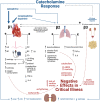Beta-Adrenergic Blockade in Critical Illness
- PMID: 34721025
- PMCID: PMC8554196
- DOI: 10.3389/fphar.2021.735841
Beta-Adrenergic Blockade in Critical Illness
Abstract
Catecholamine upregulation is a core pathophysiological feature in critical illness. Sustained catecholamine β-adrenergic induction produces adverse effects relevant to critical illness management. β-blockers (βB) have proposed roles in various critically ill disease states, including sepsis, trauma, burns, and cardiac arrest. Mounting evidence suggests βB improve hemodynamic and metabolic parameters culminating in decreased burn healing time, reduced mortality in traumatic brain injury, and improved neurologic outcomes following cardiac arrest. In sepsis, βB appear hemodynamically benign after acute resuscitation and may augment cardiac function. The emergence of ultra-rapid βB provides new territory for βB, and early data suggest significant improvements in mitigating atrial fibrillation in persistently tachycardic septic patients. This review summarizes the evidence regarding the pharmacotherapeutic role of βB on relevant pathophysiology and clinical outcomes in various types of critical illness.
Keywords: beta-blockers; critical illness; esmolol; hemodynamics; sepsis; tachyarrhythmia.
Copyright © 2021 Bruning, Dykes, Jones, Wayne and Sikora Newsome.
Conflict of interest statement
The authors declare that the research was conducted in the absence of any commercial or financial relationships that could be construed as a potential conflict of interest.
Figures


References
-
- Ahl R., Thelin E. P., Sjölin G., Bellander B. M., Riddez L., Talving P., et al. (2017). β-Blocker after Severe Traumatic Brain Injury Is Associated with Better Long-Term Functional Outcome: a Matched Case Control Study. Eur. J. Trauma Emerg. Surg. 43 (6), 783–789. 10.1007/s00068-017-0779-5 - DOI - PMC - PubMed
-
- Al-Khatib S. M., Stevenson W. G., Ackerman M. J., Bryant W. J., Callans D. J., Curtis A. B., et al. (2018). 2017 AHA/ACC/HRS Guideline for Management of Patients with Ventricular Arrhythmias and the Prevention of Sudden Cardiac Death: A Report of the American College of Cardiology/American Heart Association Task Force on Clinical Practice Guidelines and the Heart Rhythm Society. Circulation 138(13), e272-e391. doi: doi:10.1161/CIR.0000000000000549 - DOI - PubMed
-
- Alali A. S., Mukherjee K., McCredie V. A., Golan E., Shah P. S., Bardes J. M., et al. (2017). Beta-blockers and Traumatic Brain Injury: A Systematic Review, Meta-Analysis, and Eastern Association for the Surgery of Trauma Guideline. Ann. Surg. 266 (6), 952–961. 10.1097/SLA.0000000000002286 - DOI - PMC - PubMed
Publication types
LinkOut - more resources
Full Text Sources

